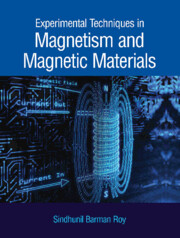Book contents
- Frontmatter
- Dedication
- Contents
- Preface
- I Introduction to Magnetism and Magnetic Materials
- II Basic Phenomenology of Magnetism
- III Experimental Techniques in Magnetism
- Appendix A Magnetic Fields and Their Generation
- Appendix B Units in Magnetism
- Appendix C Demagnetization Field and Demagnetization Factor
- Index
Appendix B - Units in Magnetism
Published online by Cambridge University Press: 27 October 2022
- Frontmatter
- Dedication
- Contents
- Preface
- I Introduction to Magnetism and Magnetic Materials
- II Basic Phenomenology of Magnetism
- III Experimental Techniques in Magnetism
- Appendix A Magnetic Fields and Their Generation
- Appendix B Units in Magnetism
- Appendix C Demagnetization Field and Demagnetization Factor
- Index
Summary
In 1960 the Systeme International d’Unites (SI) was recommended as the modern version of the metric system, which replaced the old CGS – centimetre, gram, and second – system with seven fundamental or “base” units: the metre, kilogram, second, ampere, kelvin, mole, and candela. Other “derived” units are constructed from these base units. Since then in almost every area of science and engineering, the SI units have been widely used unambiguously.
In the field of magnetism, however, a kind of confusing mixture of SI (in various versions) and CGS units are still being used sometimes. For example, “magnetic field” can mean “B-field” or “H-field”. The SI units for these fields are tesla (T) or amperes per metre (Am−1), whereas in CGS those are gauss (G) and oersted (Oe), all of which are currently in use. Another source of confusion arises due to the different expressions proposed for the magnetic induction B in a polarizable medium by Arthur Kennelly (1936) and Arnold Sommerfeld (1948) [1]. The Kennelly system is traditionally followed by electrical engineers, where B is expressed as:
Here μ0 is the permeability of free space, H is the H field, J is the magnetic polarization, and B0 is the induction of free space that would remain in the absense of the medium. In the Sommerfeld convention, which has been adopted by the International Union of Pure and Applied Physics (IUPAP):
Here M is the magnetization per unit volume. These equations are not in conflict once it is recognized that magnetization and magnetic polarization are different quantities. It is possible to use either the B-field or the H-field when one is dealing with the magnetic field. They can be distinguished by their behaviour at a boundary between media having different relative permeabilities (μ). Across the boundary of the media the normal component of the B-field and the tangential component of the H-field will be continuous. In both the Kennelly and Sommerfeld systems B = μ0Hin the free space. In SI units μ0 = 4π × 10−7 henreys per metre (Hm−1), hence B-field and H-field have different numerical values. On the other hand, in the CGS system μ0 = 1, hence B-field or the H-fields have identical numerical values.
- Type
- Chapter
- Information
- Experimental Techniques in Magnetism and Magnetic Materials , pp. 325 - 328Publisher: Cambridge University PressPrint publication year: 2023



